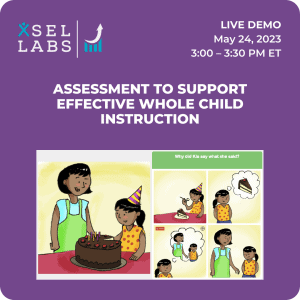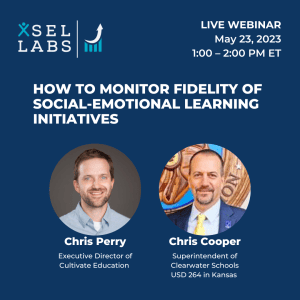Four Key Challenges for the Field of Social and Emotional Learning (SEL)
At the risk of stating the obvious, SEL has gotten big. Before the pandemic, most educators reported engaging in some kind of SEL practice in their schools. The pandemic has only accelerated interest in how we can support student social and emotional well-being. As SEL continues its massive growth, there are likely to be some growing pains. In this blog post, I discuss four specific SEL challenges (challenges facing the field of SEL) and offer some ideas of how all four can be addressed.
SEL Challenge #1: Maintaining Quality at Scale
Education, human services, social welfare, and public health, among other population-based service systems, face predictable barriers to maintaining quality at scale. The story usually unfolds like this: Innovative program designers create a way to address a problem—such as how to teach students social and emotional competencies. They team up with researchers who conduct a rigorous evaluation study. That study typically takes place in highly committed schools and includes a great deal of support for high-quality implementation. The study shows that compared to students who did not receive the program, students who did demonstrated measurable gains on important outcome measures. Thus is born an evidence-based practice (EBP).
So all you have to do is get the EBP into every school to have a massive positive impact. Turns out that is a very, very difficult thing to do. Some school districts will be able to implement SEL programs with the kind of high quality and intensity that produces the kind of student benefits shown in the evaluation studies. But many will struggle. Some will purchase curricula, for example, that never get out of the proverbial shrink wrap. Perhaps some teachers will use a curriculum with great gusto and others will not. Perhaps teachers will resist the requirement to do “one more thing” or will not feel confident that they can teach something unfamiliar and non-academic. There are many reasons why just shipping an EBP without systemic supports for its constructive use may not be implemented in a way that benefits students measurably.
A related SEL challenge is the proliferation of practices that are labelled SEL for which there is no evidence that they produce a benefit. One educator I met reported that his approach to teaching self-management was to offer fidget spinners to his students. He could not detect a meaningful change in student self-management, except that students without the fidget spinners became distracted by the whizzing in their peripheral vision.
The question here is how can we ensure that SEL EBPs are executed in a way that maintains their effectiveness? And how can we guard against ineffective programs being labelled SEL, thereby diluting the overall benefit of the SEL endeavor?
SEL Challenge #2: Standardization Versus Customization
A second SEL challenge is the tension between standardization and customization. On the one hand, the best way to ensure that a program produces the kind of measurable benefit shown in rigorous evaluations is to implement it with fidelity. That means running through the program as it was designed, with sufficient intensity, in a way that engages students. In other words, follow the program as written. This is a form of standardization.
One of the SEL challenges is that in any given community, some elements of an SEL program might feel like a good fit, and others might not. Or a creative teacher might simply have an idea about how to teach a lesson in a different way than described in the scope and sequence. Standardization in these cases can feel like a limitation. And let’s face it, educators are a creative bunch. We can count on them to customize a curriculum to some degree.
The question is—how far from the original design of an EBP can an educator go and still be confident that it will benefit students? Rigid standardization is not realistic. But an anything goes approach risks sacrificing the elements of an SEL program that work. Is it possible to create approaches that allow for customization within instructional design parameters such that so long as those broader principles are executed, we can be confident that the program will work?
SEL Challenge #3: Academic Integration
One of the key studies demonstrating the efficacy of SEL programs was a meta-analysis, or quantitative summary of many studies, that was published in 2011. In that meta-analysis, the authors found that the most effective programs embodied a sequenced, active, focused, and explicit approach to teaching social and emotional skills. This finding supports the use of SEL programs and curricula with a scope and sequence that is taught apart from academic instruction.
The challenge, as I mentioned previously, is that teachers are asked to do a great deal and adding “another thing” to their already packed to-do list can be difficult. In addition, some have argued that teaching SEL takes time away from academic instruction and therefore is not consistent with the mission of schools, which is in part to nurture academic skills. In fact, the same meta-analysis showed that SEL programs done well produce positive academic outcomes, so it does not appear to be a zero-sum choice between SEL and academics.
As a result, educators are looking for creative and effective ways to integrate SEL into academic instruction. Stephanie Jones talks about SEL “kernels” or specific and easy-to-implement teaching practices known to nurture SEL. Bridget Hamre and her team work to support excellent instruction that supports SEL using their CLASS assessment. Some programs, such as Rosen Publishing’s Focus on Social and Emotional Learning and Collaborative Classroom’s Caring Schools Community thoughtfully embed social and emotional instruction within literacy instruction.
There are ways to integrate SEL into academic instruction. The question is how much stand-alone SEL is required and how much can SEL be woven into academic instruction for it to remain beneficial to students? And in the end, what does the ideal mix of stand-alone and integration look like? The field has not yet answered these questions.
SEL Challenge #4: Supporting Equity
Finally, the field of SEL, like every nook and cranny of American society, is facing important questions about how it can support racial equity. Some have argued that SEL programs seek to impose white middle class values on communities of color and therefore harm children. Similarly, others have argued that any SEL that is not anti-racist is racist. Still others have expressed concerns that in explicitly focusing on equity, SEL reflects a liberal agenda not shared by all.
There is evidence that even as they are currently designed, SEL programs can and do support equity. Many districts have adopted SEL programs to further equity by replacing punitive and disproportionate discipline practices with a strengths-based approach to supporting students. In addition, meta-analyses have found that students from diverse demographic backgrounds all benefit similarly from SEL programs.
Nevertheless, more can be done to ensure that SEL programs are truly engines for change while not becoming overly politicized. The Collaborative for Academic Social and Emotional Learning recently revised their description of social and emotional competencies to add considerations of equity. For example, self-awareness now includes awareness of one’s own biases and prejudices. This expanded definition maintains the original competencies and adds equity-focused competencies.
The question for the field is how we can evolve so that SEL is a demonstrable force for equity in ways that, just as CASEL had done with its definition of social and emotional competence, maintains the positive elements of what has been built, and adds innovations that are supportive of greater equity? And how can we do so in ways that prevent SEL from becoming a political football?
Facing these Challenges
All four of these SEL challenges—maintaining quality at scale, reconciling standardization and customization, academic integration, and equity—will produce changes to SEL practices. Many educators may modify and customize programs. Others will find creative ways to integrate academics and SEL and may do this instead of a more formal program. Others may alter SEL programs, so they are not centered on white middle-class values. These changes are inevitable.
The question is, will they work? By working, I mean, will any of these or the myriad other ways SEL practices might evolve continue to produce measurable benefits in student outcomes?
In my view, one of the most important ways for SEL programs and practices to continue to benefit students, even as those programs and practices change form, is to integrate SEL assessment as part of a continuous improvement process wherein periodic measurement—of SEL practices, school climate, and student competencies—both guide adult actions and provide data on what is working and what is not. Keep the practices that produce positive outcomes; leave the rest behind.
Assessment data is certainly not the only thing that is needed to ensure the field evolves in a healthy way. But it seems to us at xSEL Labs that without deeply integrating data into SEL practice, it will be hard to know if SEL continues to be a force for the good or has lost its way.



